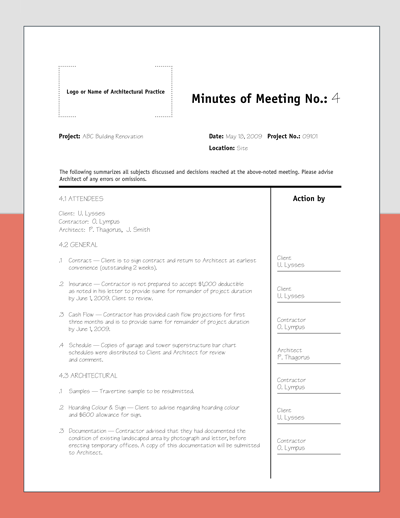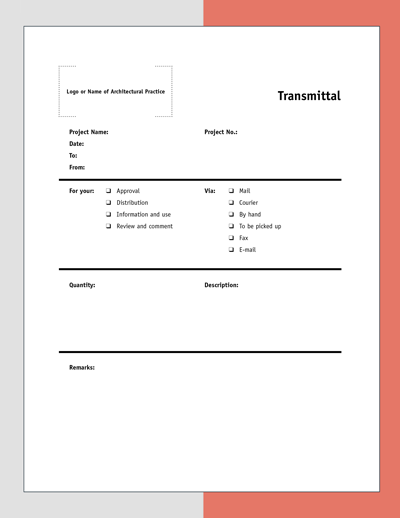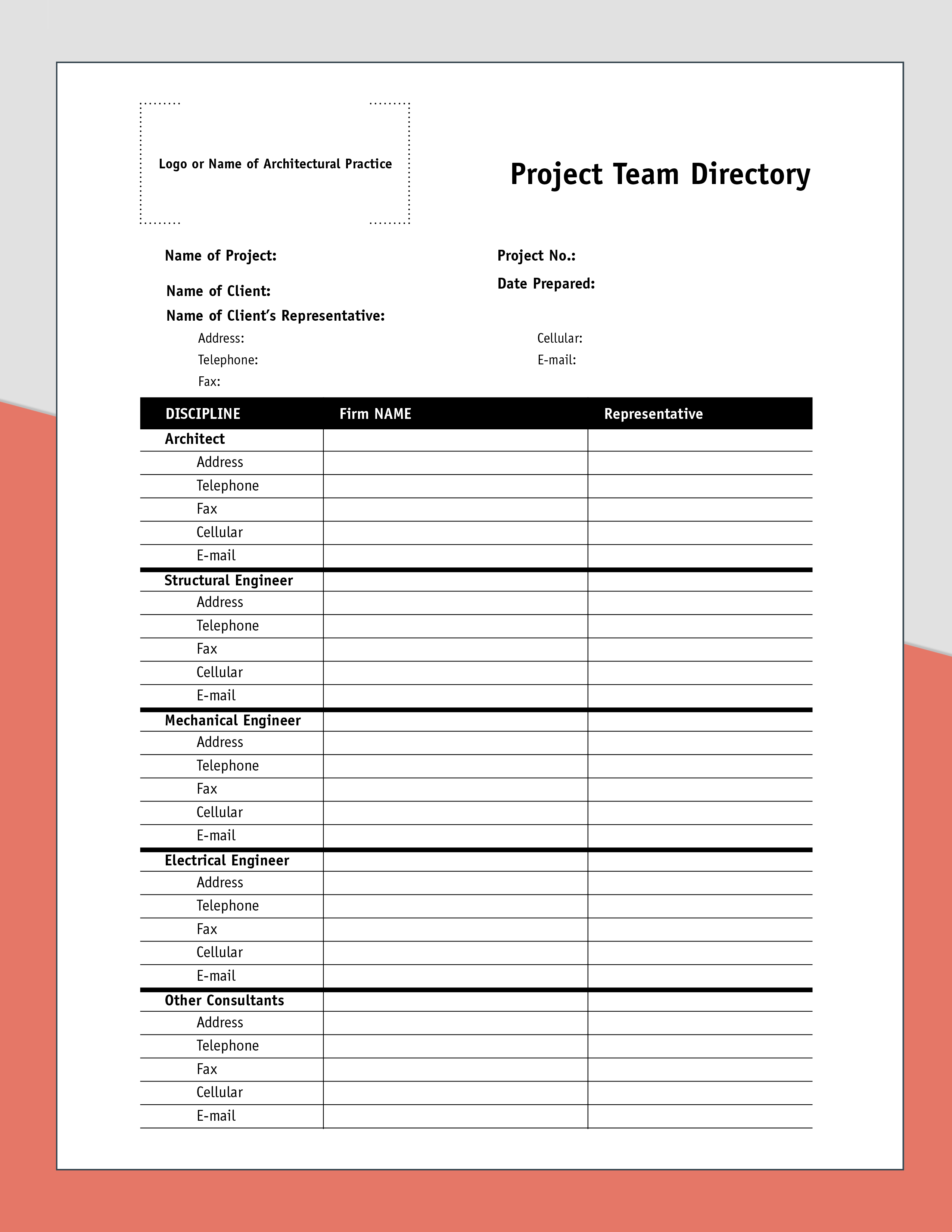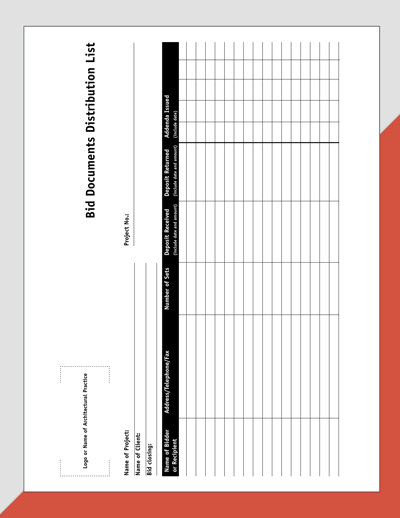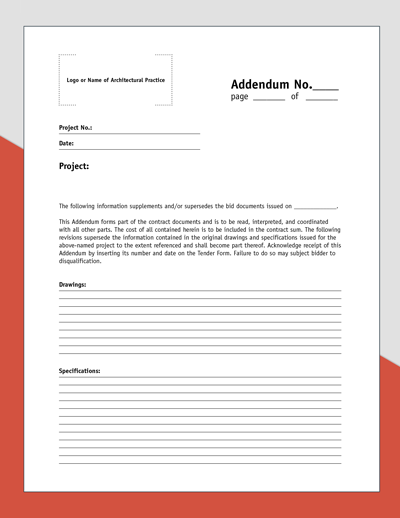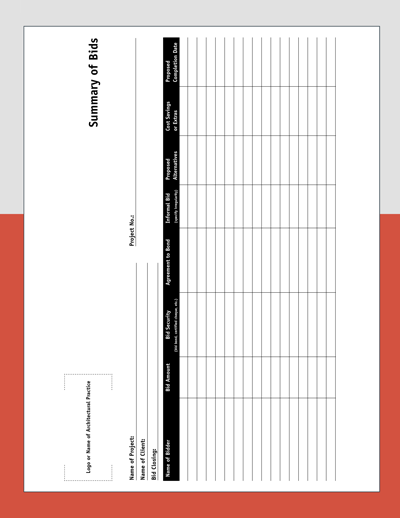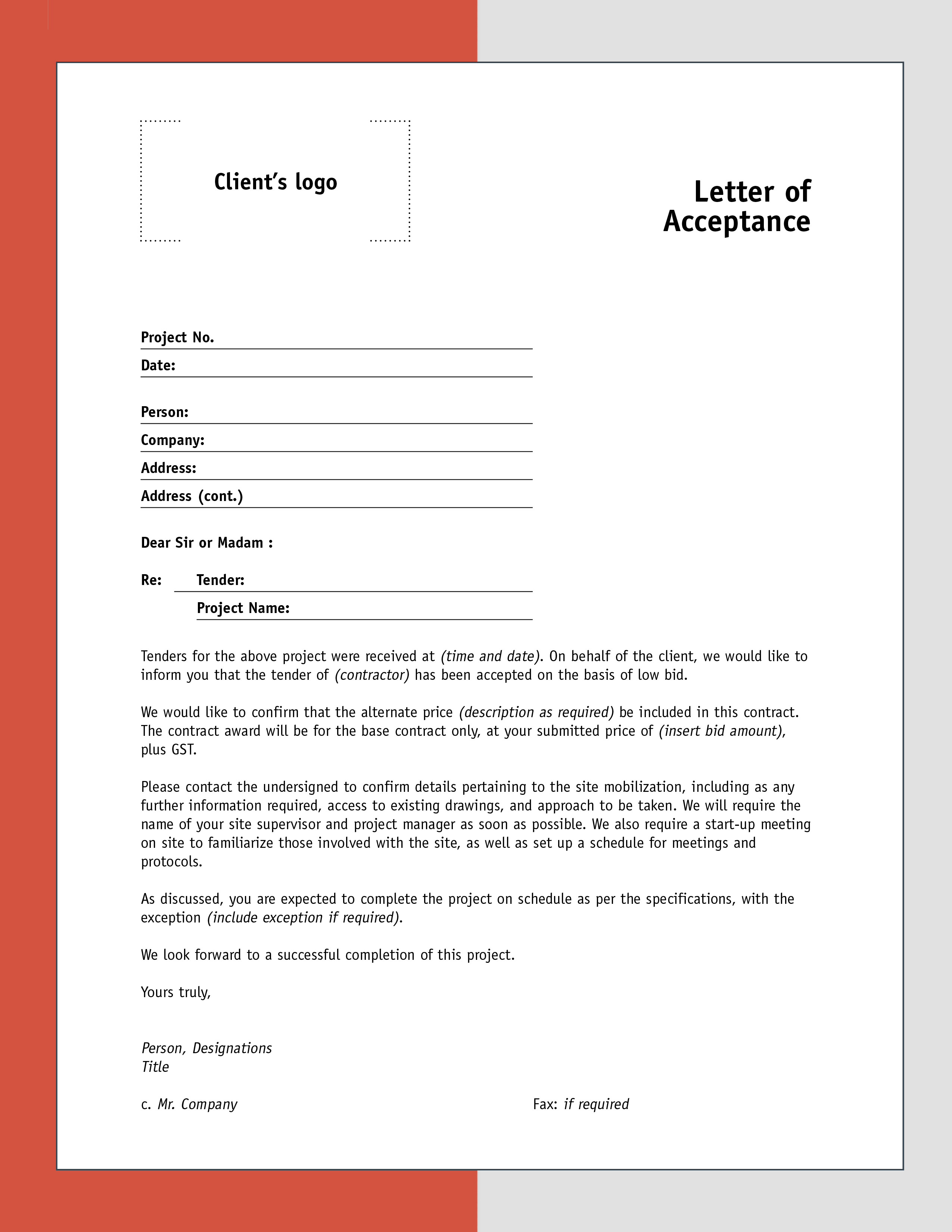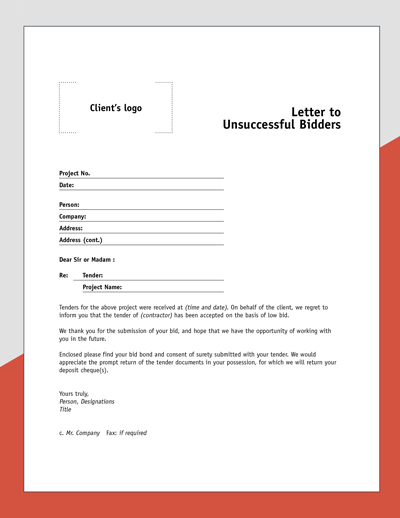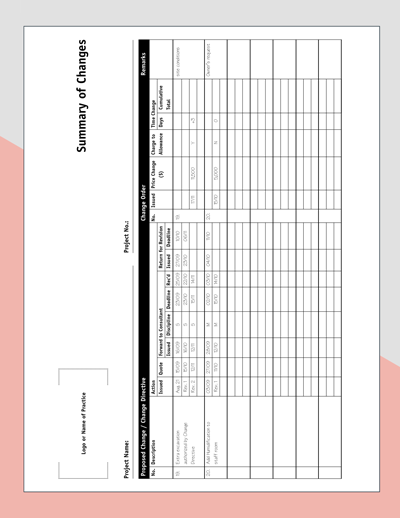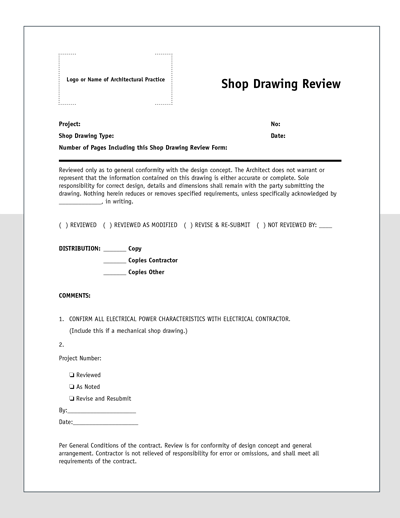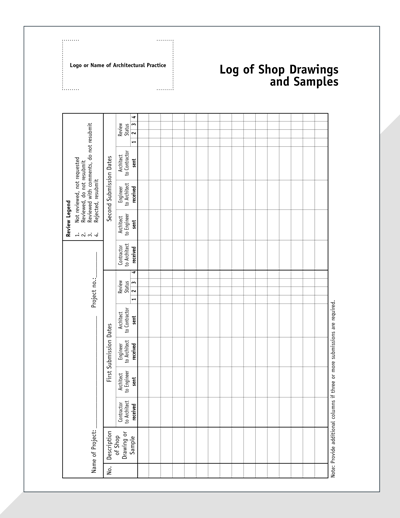Guide to the Use of the Forms
Purpose of the Forms
The forms in this section of the Handbook are provided to assist the architect in managing a project. Standardized forms support effective record-keeping and other functions. As well, many of these forms are needed to fulfil contractual requirements.
Many of the forms discussed may be available in various digital and/or web-based formats and platforms. The forms presented are designed simply to illustrate recommended content.
The Handbook does NOT duplicate forms which are available from the Canadian Construction Documents Committee (CCDC), such as those in CCDC 24, A Guide to Model Forms and Support Documents (for use with CCDC 2).
Other Forms
This section of the Handbook provides only the basic forms used to manage most architectural projects. Other forms which may be required include:
- Survey Requirements (to be provided to land surveyors)
- Index of Drawings/Sketches
- Index of Drawing Revisions
- Index of Subcontractors
- Index of Minutes of Meetings
- Index of Field Review Reports
- Record of Committed Funds (to track expenditures from a contingency fund)
1. Forms for General Communications
1.1 Memorandum
A memorandum, or memo, is used as a note when a letter or more formal correspondence is not required. When distributed outside the architectural practice, the memo is usually initialed or signed at the bottom of the message or next to the name of the sender. The text should be clear, concise, and correct.
Purpose
A memorandum is used to:
- transfer, confirm, record, and file miscellaneous information both within and outside the office;
- act as a reminder of outstanding business or action required.
Contents
The memo contains the following information:
- recipient;
- sender;
- date;
- preferably, date due where action is required;
- file or project name and number;
- title of the subject matter;
- body of text or information;
- associated attached documents or hyperlinks to them.
1.2 E-mail
E-mail is an acceptable format for communication when the message is brief, will take a minimum amount of time to compose, there are multiple recipients, a signature is not required, and a quick response is requested. E-mails are less appropriate when the message is lengthy, highly detailed, and a formal writing style and format are required. In the latter situation the sender should consider writing a memorandum and attach it to a brief e-mail indicating the action to be taken. E-mail should be avoided when a telephone conversation or a face-to-face meeting is more appropriate, such as addressing conflict or an emotionally charged situation.
Many server- and web-based applications and platforms provide electronic communication functionality that integrates both practice and project management communications and processes.
1.3 Minutes of Meeting
Minutes of meetings are used to document the events that occur and the actions that arise or are resolved at meetings, including telephone calls or telephone conferences. Minutes of meetings may also be referred to as meeting reports or conference reports.
Purpose
Minutes are a record of items discussed or agreed upon at meetings, as well as actions assigned to attendees. They should include the purpose of the meeting, a list of attendees, and an action column indicating the name of the individual or firm responsible for follow-up.
Contents
The minutes should provide the following information:
- project name and number;
- date of meeting or discussion;
- date of report issuance if different from meeting/discussion date;
- location, or an indication that the item arises from a telephone discussion;
- purpose/subject of meeting or discussion;
- list of attendees;
- list of other persons to be copied on the notes arising;
- record of decisions made;
- action(s) required;
- due date(s) for action(s);
- person(s) assigned to undertake the action(s);
- if there is a sequence of actions arising, such as a submittal review, then the work flow should be identified if it is not a pre-agreed sequence such as for change order review.
Current communications technology increasingly allows for the management, closure and record-keeping of individual meeting items outside of and between meeting events. Where this occurs, it is a best practice to table actions completed since a previous meeting at the next team meeting, in order that individuals not “in the loop” are made aware of progress and resolutions.
1.4 Transmittal
A transmittal is a convenient form which records the routing of drawings, specifications, sketches, shop drawings, samples, product literature, and other documents which are transmitted electronically or by other means.
Purpose
The transmittal is used to:
- record and document the information transmitted;
- record the date of transmission;
- indicate the action expected upon receipt of the information;
- direct the routing and mode of delivery.
Contents
Transmittals contains the following:
- date;
- addressee, assignee and/or recipient;
- project name and number;
- method of transmittal;
- action required;
- associated due date(s);
- itemized list of documents or information;
- remarks or additional notes pertaining to the information;
- names of recipients also receiving same items or information.
Note that it is important to identify the assignee(s) for any action required, to avoid several people taking independent actions when they were included in the distribution list for information purposes only.
1.5 Project Team Directory
This is a complete list of the representatives of the various organizations involved in a project and their contact information.
Purpose
The directory provides a simple, accessible source of contact information for communication purposes.
Contents
The directory should include:
- name of firm or organization, including organization’s website address if available;
- name and title of individual;
- role of individual on the project, which may be different than their general title;
- address;
- telephone and fax number (usually business telephone, but sometimes emergency or home telephone numbers are important);
- cellular telephone number;
- e-mail address;
- address of any associated project website, intranet, etc.
2. Forms for the Bidding Phase of a Project
For a general discussion of this phase of a project and for the application and use of these forms, see also Chapter 6.5 - Construction Procurement.
2.1 Bid Documents Distribution List
It is important to track the distribution of documents when a project is “out for tender.”
Purpose
The list is used to:
- identify all bidders and other recipients;
- record deposits for documents;
- provide a distribution list for addenda;
- provide a checklist to secure the return of documents after bid closing.
Contents
The Bid Documents Distribution List should include the following information:
- project name and number;
- bid closing time and date;
- name, address, e-mail, telephone and fax numbers of all contractors (bidders and other recipients);
- number of sets of documents received;
- date of issue and date of return of sets of documents;
- deposits received and returned;
- number of addenda issued and date of issue.
2.2 Stipulated Price Contract Bid Form
See Chapter 6.5 – Construction Procurement and CCDC 23, A Guide to Calling Bids and Awarding Construction Contracts for information on developing a bid form.
2.3 Addendum
All addenda must be carefully worded and distributed, as they will form part of the construction contract. Addenda may contain revised or additional drawings. They must be distributed to all bidders and others at the same time, in the same manner, and generally no later than four days prior to bid closing. The time period for latest addendum issuance should be included in the project’s bid documents.
See Chapter 6.5 – Construction Procurement and CCDC 23, A Guide to Calling Bids and Awarding Construction Contracts for more information on addenda.
Purpose
Addenda are used to:
- provide additional information to be included in the bid documents;
- correct or clarify information in the bid documents;
- identify changes in the instructions to bidders (closing date, time, etc.).
Content
The addendum should include the following information:
- project name and number;
- number and date of the addendum;
- number of each addendum item within the addendum document;
- a reference to the appropriate bid documents (drawing, specification, instructions to bidders, etc.);
- a detailed description of the new information, including its location in the proposed building as well as in the bid documents;
- contact information for the person at the architect’s office who is able to discuss addenda items if necessary (for clarifications, not new or revised information).
2.4 Contractor’s Qualification Statement
When inviting a contractor to bid, a contractor with whom you have little or no experience, it is important to use a standard form to record information that can be used to confirm the contractor’s qualifications.
A commonly used form is CCDC Document 11 Contractor’s Qualification Statement. See Chapter 6.5 – Construction Procurement and CCDC 24, A Guide to Model Forms and Support Documents for information on the use and application of this form.
2.5 Project Financial Information
Refer to CCDC 12, Project Financial Information for a sample form. Refer to CCDC 24, A Guide to Model Forms and Support Documents for information on the use and application of this form.
2.6 Summary of Bids
This form is both a record of bids and a tool for analyzing them.
Purpose
The summary of bids:
- provides a list for easy comparison and analysis;
- identifies bids which are non-compliant;
- is useful as a preliminary record during opening of bids.
Contents
The form must contain the following:
- project name and number;
- bid closing time and date;
- list of contractors submitting bids;
- list of bid amounts;
- list of acceptable bid securities (bid bond, certified cheque, etc.) and confirmation of receipt for each bidder;
- identification of possibly non-compliant bids;
- list of alternatives or proposed substitutions;
- project completion time (if requested in bid documents).
2.7 Letter of Acceptance
See Chapter 6.5 – Construction Procurement for information on the proper use of this letter. A Letter of Acceptance is normally issued by the client or owner on the advice of their lawyer, who should review all bids; however, the architect may assist in the letter’s preparation.
Purpose
The Letter of Acceptance:
- notifies a successful bidder of the award of contract;
- permits work to start immediately, pending the preparation and execution of a formal contract.
Contents
The Letter of Acceptance may include:
- date;
- name and address of successful bidder (contractor);
- project name and number;
- date and amount of the bid;
- directions regarding commencement of the work;
- acceptance of alternatives;
- confirmation of the contract price;
- starting date of commencement of contract.
2.8 Letter to Unsuccessful Bidders
It is both professional and courteous to inform unsuccessful bidders in a timely manner of the award of a contract. The letter can be sent by the architect or the owner.
Purpose
The purpose of the Letter to Unsuccessful Bidders is to:
- notify all bidders of the status of the project;
- permit bidders to release bonding and other commitments for other projects;
- inform bidders of the actual amount of the successful contract.
Contents
The Letter to Unsuccessful Bidders may contain the following information:
- date;
- the name of the successful contractor;
- the contract amount with a brief explanation if this is different from the low bid (acceptance of alternatives, etc.);
- description of the method for returning bid documents and obtaining deposits on these documents;
- indication of the method for return of bid bonds or bid security, if necessary;
- a note of thanks for bidding on the project.
3. Forms for Contract Administration
3.1 Field Review Report
Field Review Reports are a log of observations made and actions assigned and/or taken during the construction and post-construction stages of a project. These reports are often supplemented by audio recordings and photographic or video records.
See Chapter 6.6 – Contract Administration – Office and Field Functions for more information on the preparation of Field Review Reports.
Purpose
Field Review Reports are used to:
- record observations about construction activities, summarizing the observed status of the project at regular intervals. These are communicated to the client, authorities, consultants and the contractor;
- identify observed non-conformances and deficiencies for contractor action;
- identify resolution of previously observed non-conformances and deficiencies;
- manage other information;
- assist in processing the contractor ’s applications for payment and the preparation of Certificates for Payment;
- create a project history to assist in providing documentation and findings regarding possible future claims.
Content
Field Review Reports should contain the following information:
- project name and number;
- location of project;
- number of the Field Review Report or other means of identification;
- date of visit;
- date of report, if different from date of visit;
- name of general contractor;
- weather conditions;
- general observations, including stage of construction;
- description of observed work in progress;
- action required in relation to observations, non-conformances and deficiencies;
- name and title of person performing the review;
- names of organizations and representatives who will receive the report;
- list of attachments;
- comment on previous reports’ “action required”;
- method of transmission.
3.2 Supplemental Instructions
Refer to CCDC 24, A Guide to Model Forms and Support Documents for the purpose of this form, a guide to its use, and a sample form.
See Chapter 6.6 – Contract Administration – Office and Field Functions in this Handbook for information on the use of the Supplemental Instruction Form.
3.3 Proposed Change
Refer to CCDC 24, A Guide to Model Forms and Support Documents for the purpose of this form, a guide to its use, and a sample form.
See Chapter 6.6 – Contract Administration – Office and Field Functions in this Handbook for information on the use and application of this form.
3.4 Change Order
Refer to CCDC 24, A Guide to Model Forms and Support Documents for the purpose of this form, a guide to its use, and a sample form.
See Chapter 6.6 – Contract Administration – Office and Field Functions in this Handbook for information on the use and application of this form.
3.5 Combined Proposed Change and Change Order
Refer to CCDC 24, A Guide to Model Forms and Support Documents for the purpose of this form, a guide to its use, and a sample form.
3.6 Change Directive
Refer to CCDC 24, A Guide to Model Forms and Support Documents for the purpose of this form, a guide to its use, and a sample form.
See Chapter 6.6 – Contract Administration – Office and Field Functions in this Handbook for information on the use and application of this form.
3.7 Summary of Changes
Refer to CCDC 24, A Guide to Model Forms and Support Documents for the purpose of this form, a guide to its use, and a sample form.
3.8 Notice
Refer to CCDC 24, A Guide to Model Forms and Support Documents for the purpose of this form, a guide to its use, and a sample form.
3.9 Warranty Notice
Refer to CCDC 24, A Guide to Model Forms and Support Documents for the purpose of this form, a guide to its use, and a sample form.
3.10 Product Warranty Notice
Refer to CCDC 24, A Guide to Model Forms and Support Documents for the purpose of this form, a guide to its use, and a sample form.
4. Forms for Certification
4.1 Certificate for Payment
Refer to CCDC 24, A Guide to Model Forms and Support Documents for the purpose of this form, a guide to its use, and a sample form.
See Chapter 6.6 – Contract Administration – Office and Field Functions for information on the use and application of this form.
4.2 Certificate of Substantial Performance
The requirement for a Certificate of Substantial Performance and the type of form varies in each province and territory and is based on the relevant construction lien legislation. The architect should confirm which form is suitable in the province or territory in which the project is undertaken. The applicable lien legislation may prescribe the form to be used for the certification of substantial performance. See Chapter 6.7 – Take-over Procedures, Commissioning, and Post-occupancy Evaluations for additional information on substantial performance.
Note that lien legislation may prescribe maximum time periods for certain actions to be completed (e.g., preparation of certificate after review, timeliness of posting certificate, etc.). Such prescriptions are NOT guidelines, they are laws. Failure to meet legislated time periods is much more serious than, say, forgetting to distribute a Field Review Report in a timely fashion.
4.3 Statutory Declaration Forms
Refer to CCDC 9A, 9B, and 9C for sample forms. Refer also to the applicable lien legislation in the province or territory in which the project is undertaken, which governs.
Refer to CCDC 24, A Guide to Model Forms and Support Documents for information on the use and application of these forms.
4.4 Application for Payment
Refer to CCDC 24, A Guide to Model Forms and Support Documents for the purpose of this form, a guide to its use, and a sample form.
See Chapter 6.6 – Contract Administration – Office and Field Functions for information on the use and application of this form.
4.5 Schedule of Values and Work Performed
Refer to CCDC 24, A Guide to Model Forms and Support Documents for the purpose of this form, a guide to its use, and a sample form.
See Chapter 6.6 – Contract Administration – Office and Field Functions for information on the use and application of this form.
4.6 Letters of Assurance
A Letter of Assurance is a requirement in some jurisdictions, including the provinces of British Columbia, Alberta and Nova Scotia. All architects practising in these jurisdictions should refer to the appropriate guides regarding Letters of Assurance in the local building codes and in bulletins from the provincial association of architects.
Generally speaking, Letters of Assurance must be signed, sealed, and dated by registered architects who are practising (principals) in architectural firms or who hold a certificate of practice or authorization in designated engineering firms.
Purpose
The Letters of Assurance are used to provide certification to authorities having jurisdiction at two milestones:
- application for building permit;
- intention to occupy the building.
Content
Always use the standard form of the Letter of Assurance from the appropriate jurisdiction for the place of the work. For example, in British Columbia refer to the latest edition of the British Columbia Building Code or the Vancouver Building Bylaw equivalent for sample letters.
5. Other Forms for Project Management
The architect can use many forms to assist in the management of a project.
5.1 Index of Supplemental Instructions
Refer to CCDC 24, A Guide to Model Forms and Support Documents for a typical Supplemental Instruction Form.
When numerous supplemental instructions are issued to clarify or interpret the contract documents, a reference list is needed to track all instructions issued. This may be done as a separate list, or may be a report available from a project database that includes such instructions.
Content
On an index of supplemental instructions, provide the following information:
- project name and number;
- numbers of the supplemental instructions (in chronological or other agreed order);
- descriptive title for each instruction;
- details of instruction—location; instruction in active imperative;
- the representative who initiated the instruction. Regardless of whether an instruction arises directly from the architect or from another consultant, it is better that all instructions be issued by the architect, for coordination purposes;
- reason for the instruction, to explain the need for the supplemental instruction to appropriate project stakeholders;
- date of issue of the supplemental instruction;
- indication of whether or not a change order was eventually required, with a reference to its identifier.
5.2 Drawing Notations
The following common notations applied to drawings indicate the stage of development of a design or construction document. In addition, the notation indicates a restriction or clarification for the document’s use. These notations may be applied using either an electronic or manual stamp.
Numerous drawing review applications with built-in stamping features are now available that provide functionality for quickly notating drawings.
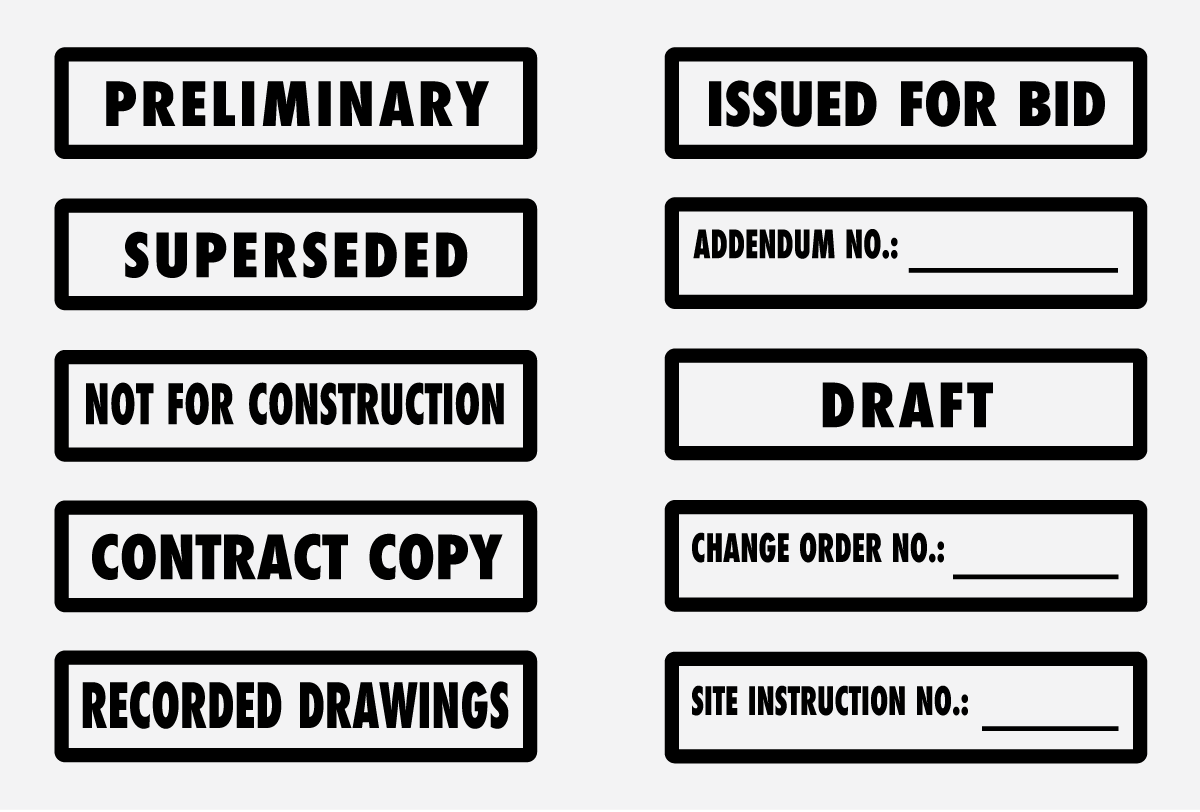
5.3 Shop Drawing and Submittals Review Letters and Stamps
The review of shop drawings, the use of the appropriate cover letter and the application of notations to the shop drawings have significant implications regarding professional liability and legal responsibility. See Chapter 6.6 – Contract Administration – Office and Field Functions for the use and application of the shop drawing cover letters and notations.
The following wording is suggested for a shop drawing stamp:

The following are other possibilities for cover letters.
1. For shop drawings which are not required:

2. For shop drawings with engineering content only:

[Note: Clarify in the cover letter that shop drawings have not been reviewed by the architect.]
3. For shop drawings to be reviewed only by the architect:
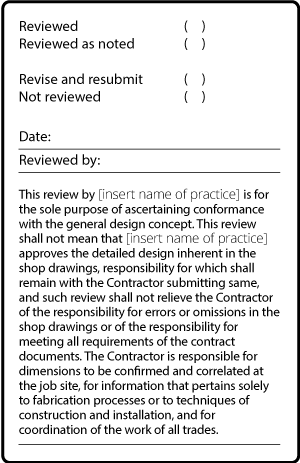
4. For shop drawings with engineering elements which must also be reviewed by the architect:
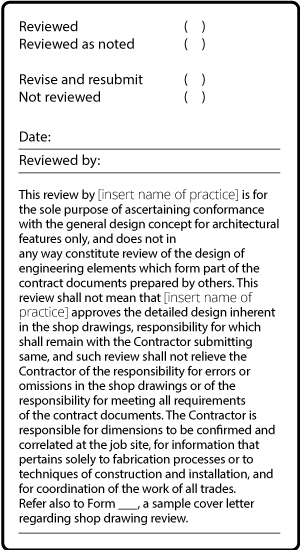
Refer also to Form 3.1c, a sample cover letter regarding shop drawing review.
5.4 Log of Shop Drawings and Samples Submittals
It is important to ensure the timely review and tracking of all shop drawings and samples, both within the architect’s office and by consultants. This log assists in the efficient management and distribution of shop drawings and samples. The log may be a stand-alone document or a report from a database of submittals.
As a best practice, items within the log of shop drawings and samples may be listed or filed using the MasterFormat™ system. At completion of the project, a copy of the log should be filed with the project’s shop drawings.
Purpose
The submittals log:
- provides a list of all required submittals;
- identifies submittals required but not yet received;
- determines the status of the review and distribution of submittals as well as approval status;
- provides a checklist for the preparation and review of a manual during “take-over.”
Content
The shop drawings and samples log may contain the following:
- type of submittal: shop drawing, sample, manufacturer’s literature, sample warranty, etc.;
- title of the submittal;
- drawing number if a shop drawing;
- date of preparation of the submittal;
- MasterFormat™ number or similar identifier for the product or system;
- company or trade responsible for preparing the submittal, including contact information;
- date received;
- submittal work flow:
- name of consultant to whom the drawing or sample was referred for review;
- date of referral;
- date that the shop drawing or sample is returned;
- date that the shop drawing is forwarded to the general contractor;
- status of the shop drawing or sample (e.g., reviewed, reviewed as noted, or resubmit).
|
FORM 1.1 Memorandum |
FORM 1.3 Minutes of Meeting
|
FORM 1.4 Transmittal
|
|
FORM 1.5 Project Team Directory |
FORM 2.1 Bid Documents Distribution List |
FORM 2.3 Addendum |
|
FORM 2.6 Summary of Bid |
FORM 2.7 Letter of Acceptance |
FORM 2.8 Letter to Unsuccessful Bidders |
|
FORM 3.1 Field Review Report |
FORM 3.7 Summary of Changes |
Request for Information Sample Form |
|
Shop Drawing Review Sample Form |
Log of Shop Drawings and Samples Form |


